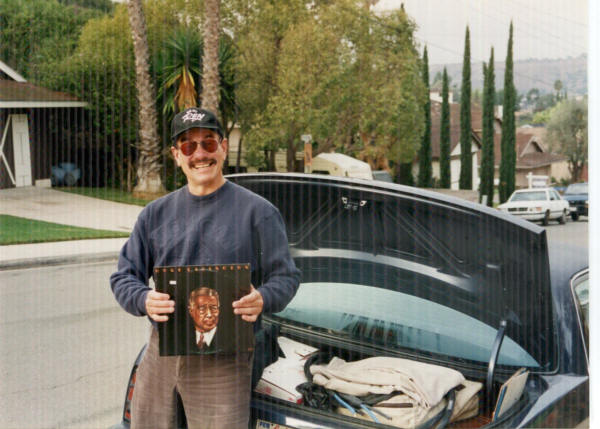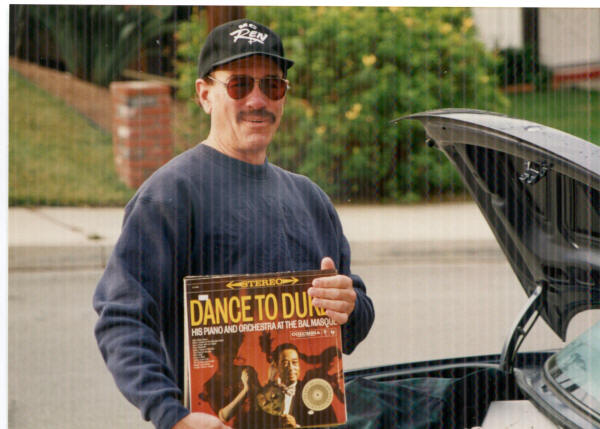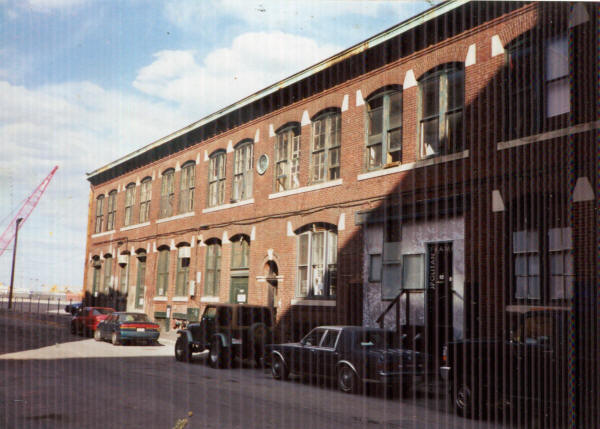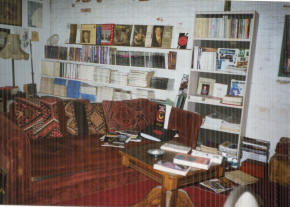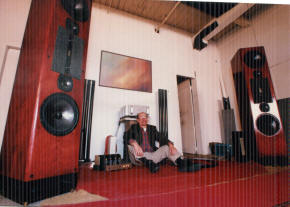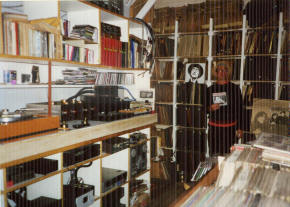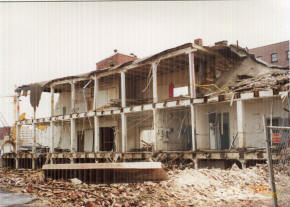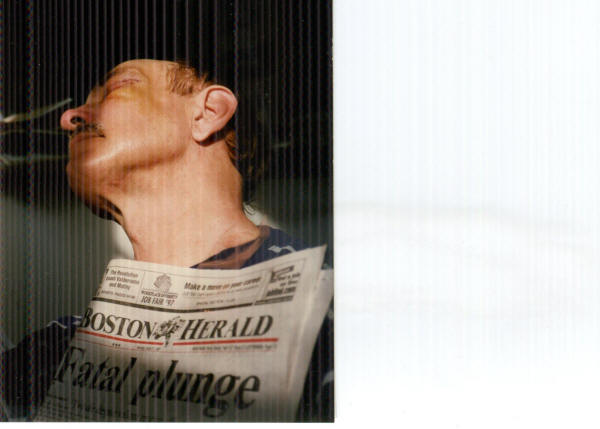You are reading the older HTML site
Positive Feedback ISSUE 69
From Clark Johnsen's Diaries: A Riddle, a Trip, and a Promise Broken
This is an expanded version of an article that appeared in print in Positive Feedback Vol. 6, #3, mid-1996, and the P.O.V. remains fixed at that date. Never before seen online, it's one of my favorites. / cj The Riddle I posed this once before, so regular readers know the answer already. I shall name three prominent groups in high-end audio. Which group of people, then, is most able—not various exceptional members thereof, but their category as a whole—to set up a really great audio system? Ready? 1) Reviewers. 2) Retailers. 3) Designers. Yes, it's tricky -- take your time. Got the answer yet? Of course! Designers! They really care! They be as gods! They grace the front covers of Audio Adventure and Positive Feedback. Their faces beam at us from the Audio Advisor catalog. Their persons and products are sung worldwide. Without designers, where would we be? They alone have the basic skill set needed to create a perfect system, right? Sorry, wrong. Most of them wear enormous blinkers, hearing truly only the particular segment each produces. Total systems? Forget it. Most designers too are ferocious egomaniacs; only with a precious few can one even have a decent conversation, approaching a 50-50 balance. So much they talk, so little they listen—makes you wonder. Also they can act, well, rather catty towards each other. No, not designers. Please, God, let it not be designers! Retailers! Yes! They enjoy continuous access to product and spend months or years living with it. Plus retailers earn their living directly from sound, so it must behoove them to make sure it's right... right? Sorry, wrong. Ask any honest retailer what factor sells equipment better, good sound or good reviews. And discovering the answer, can it be any surprise that the former consideration occupies a low spot on their totem pole of concerns? Why should they bother even to care, much less to assemble superior systems? Well, then, Reviewers? Ha! Hah! [Emitting here my most shrill, piercing cackling laugh] Hahahahaaaahaaahhahaaahahahaha!!!Talk about the misbegotten! They all have this huge jones for new kit to try; how could you expect anyone hooked on variety of audio experience to settle on what's best? Plus, most reviewers have daytime jobs and families too, with little time left over to do the work and write it up right. (See my cautionary sidebar: "Why I do not review audio gear" (read why here) Then, right in front of me once, a prominent scribe brazenly solicited a bribe. On other memorable occasions I was summarily snubbed by these worthies, but that was before becoming a mighty member of the press myself, or before they became members of the industry and duly solicitous of my feelings. Finally, almost every reviewer's system I've ever heard sounds like mediocre merde, a report I've heard from many another traveler. So who, then? The correct answer was first broached by [the late, great] Brian Cheney, he of VMPS loudspeaker fame, of the many to whom I posed the riddle, and it came to him immediately: nor shall I ever forget the phraseology: "Well, it certainly can't be any of those!" No more riddles With that glittering thought in mind I embark on my third annual post-CES California tour with a trunkful of goodies in tow to visit retailers, designers, reviewers, friends and relatives. What a story! It deserves a full retelling, but for now let me just brush in some highlights. Overall, however, the sound I find is not very good, perhaps no better than at the Show itself. Yet everyone blames those nasty hotel rooms. To my mind, best by far among the genus Reviewers is Dave Glackin [also recently, sadly, deceased], my good friend and esteemed colleague here at Positive Feedback. And even his system sounds not so well, until we dip into my movable feast (including some dozen different new microbrews), and he's man enough to admit it. And thereby learn! A rare and refreshing exception. [Here follows in the original article a list of devices that have long been superseded, somewhat to my embarrassment, hence they are omitted.] Arriving at Dave's on a Friday I quickly blame his ET-8 loudspeakers for the shallow sound, but am I ever wrong. We whip those $1500/pr. babies into fine shape with improvements made upstream albeit changing no equipment per se. Then we spend the weekend exporting our technology to other, shall we say less receptive environments around L.A., with some happy social consequences at the very least -- dinner at Bruce Edgar's! Nowhere else when calling on reviewers have I gotten the reception accorded by Dave. Later I begin ruminating on how a susceptibility to fine-tuning devices ("tweaking") could be the hallmark of a quality system. For example, this one writer's hi-fi barely responds to my non-prescription remedies, which might conceivably be a result of inherent superiority, i.e. an imperviousness to tweaks (of which his editor has never been a fan). To the owner's credit he recognizes the dilemma and cautions me too that these D.U.T. speakers have been in situ for only a short while. In fact I find them shockingly tinny (lacking any upper-bass body) and way overpriced, although introduced to me over the telephone earlier as "likely the best speakers we've ever heard". Whatever, the system resists my tender ministrations and sounds nothing like it should considering what it costs. Elsewhere another scribe who expresses himself with confidence regarding Classic LPs vs. originals proves to have a system wholly incapable of rendering significant differences, in my opinion. Even worse, he refuses to audition any audio thing I bring in. "I don't believe in tweaking," he primly states. Yet another system beckons. We audition four selections. The reproduced polarity happens to be wrong on the first three, except the fellow doesn't hear it that way, arguing contrarily (for all the usual wrong reasons) that it must be correct—then begs off making the effort switch it. How exasperating! Still another reviewer, of recordings only, owns marginal electronics, nothing with which I would care to publish statements about sonics in a major audio magazine. To him I don't even mention my trunkful of tweaks. Enough of these lazy chaps. Onwards to Retailers! California has some grand and famous ones, qualities not necessarily congruent. Whichever, this golden state far surpasses New England, where you're lucky to find much of anything. (See Andrew Keen's desperate, humorous attempt in Listener, Autumn 1995, Vol.1, No.4) Interested anew in horns—all this recent publicity!—I seek out the Eurythmies. Not only do they sound rather unimpressive, as at CES earlier, but positively dull. Aren't horns supposed to have distinctive personalities and do certain things superbly right? Yet our host here ambles around the room touting these muffled monsters to me as though one were a child or some dense customer, extolling their virtually non-existent sonic virtues and unattuned to my gently proffered expertise. (For starts, the polarity is wrong on his first couple selections.) Then he begins ranking on my buddy who brought me over. Geez Luiz! Then there's this place up in the valley of the Valley Girls, run by very nice, sincere people who have scarcely a clue on how to make their stuff sound right. And over in a not-distant três exclusiv canyon I visit an artistic showroom run by a man who must be pulled kicking and screaming into sonic reality, although I put the effort in on behalf of an old friend. His system ends up sounding much better, but ultimately he spurns my advances (!), preferring instead just to string his illustrious brands together. Not to say they're all that way. Lucky San Diego has two fine stores, Stereo Design and Stereo Unlimited, and Bel Air has Dave Weinhart at Ambrosia [now Weinhart Designs], my favorite dealer in all the world, whom I do not hit this trip. My loss. As for Designer/Manufacturers, I refuse to divulge the slightest hint about whom I visit, or even tell stories. Mostly the conversations are one-sided and the sound barely passable. At one place I am chided for bringing along a non-audio friend. Rude! Unfortunately I have to bypass Brian Cheney, my first designer buddy and a classical-music listener extraordinaire, and therefore must needs exclude him by name lest a wrongful impression be given to those who know my regular visitation habits. The riddle! The riddle! So who does build the best audio systems?? No big secret: Pains-taking customers: Highly involved hobbyists. (Look back and you will see I did not stipulate one had to choose only from the three categories specified. Sorry for the MacGuffin.) Often have I said: Spending time earns greater rewards than spending money. Hobbyists, comprising the most devoted class, make that time available to themselves. Yes. The answer is You. Be proud, dude. Now may be a suitable time to describe the best system on the road this year: Sound Lab A-1's crossed over at 70cps to equally-tall (!) Lorton subwoofers, all driven by powerful Accuphase electronics, sourced with Forsell digital and cabled by the indefatigable Rich Katz of Allegro Sound. A curious combination, one might think, but Goddamm! It sounds great. Not only that, it responds in spades to the two tweaks we try, Marigo CD edge-pen and Benjamin "degausser", proving it to be a most revealing system, besides being an utter blast. Literally! And capable of considerable finesse as well. On this rig even your musically barren audiophile CDs are a joy to experience. Its proud owner's name is Bob Cook. A freelance aerospace designer, Bob gives remote-sensing authority Dave Glackin and myself (the Mars Lander Camera man) quite the orbital sonic tour. His house is moreover everywhere artfully furnished (with real art too) and we are warmly received as well by Mrs. Cook. After a few minutes of the Cooks' tour I remark to Bob, in her presence, "What a wonderful wife—and listening room—you have!" "Right choice of order," he laconically replies. My trip concludes at buddy Bob Prinz's home in San Diego, where a modestly respectable assembly of components sounds pretty much the way those things do without intensive care. A weekend's attention again proves most fruitful and Bob begs me to leave behind what I can. Of course! In two days I fly away anyway. Throughout all this I much enjoy his family companionship, although bedded in the RV outside. Which gives me an idea on how to hit the Western audio trail next time—with VMPS loudspeakers on board! But Bob be also a budding wine connoisseur and has promised me some righteous California chardonnay. For comparison I bring along a bottle of the real thing, a '70 Meursault, which has no right to even exist at its age, but tastes stupendous, simply stupendous. Slowly we (and Mary Jo) sip; then Bob and I listen far into the night. This wild audio high life!
The author outside Bob Prinz's home. EPILOGUE - But what, you may ask, of myself? Recently I was challenged by Scott Frankland (letters, PF Vol.6, #1) to submit the particulars of my system. Fine idea! But he provokes me with this remark about one of his regular reference systems: "I will not itemize its components here as doing so may prompt a serious case of penis envy on Clark's part." As though I would begrudge the lucky fellow with a Maserati? Hell, I admire him. Just take me for a spin someday. Plus my own penis performs quite well, thank you, Scott. So in reply, and in keeping with the current trend that declares rooms to be the most critical component, I shall describe that part first, and in later installments other equipment at my business The Listening Studio, a place that exceeds, dimensionally and conceptually, if I may say, any other space I know for sound reproduction. The main room measures 50' x 23' with a 13'-15' slanted ceiling broken by rafters, proportions chosen to emulate Symphony Hall. Walls are thick brick or 1 1/2" sistered HDF panels, the floors 1" maple laid on hard pine bias-plank supported by 8" x 12" oak joists. An isolated area backstage houses all sources and electronics. Both rooms (as well as antechambers) are comfortably appointed, the walls lined with thousands upon thousands of tapes and records from every provenance and era, put here to document and demonstrate the diverse receptacles of sonic history. Carefully, lovingly we undertake to play all these at their best while also monitoring every new format in order to understand what the commercial money power is dispensing to the public. The Listening Studio in fact was founded to explore such facets of music re-creation. Our mission includes construction of an ideal reference reproduction system—alas not yet come to fruition. Nonetheless we have made significant strides and several important discoveries, one of which resulted in publication of The Wood Effect: Unaccounted Contributor to Error and Confusion in Acoustics and Audio. [That's my book.] Sad to say, we have found that as playback technology gradually improved, recording quality declined. The combined result over several decades has yielded the "flat curve" beloved of mainstream industry, its lackey media and lazy consumers. As a corollary, on modern high-end gear older records tend to sound best, which helps explain the grand prices they now fetch. Listen: Audio as conveyed through the newsstand press constitutes a veritable fraud—like the government lottery, a tax on stupidity. Nor do these people ever concede that earlier efforts had terrific merit. Closest anyone comes, is the not infrequent (and logically absurd) statement, "The glorious sound on this CD belies its older analogue origins." Ladies and Gentlemen, truth in sound, like Br'er Rabbit, is "born in the briar patch": hard to get a bead on. Consider this writer's opinion on old 78s: Fantastic sound! Virtually unbeatable for some instruments, in particular voice and cello. Whoever hears these fast spinners at The Listening Studio will agree. But hardly one famous name in "the high end" (with the notable exception of Lew Johnson) has dared to pursue this hot lead. Instead they are scornful of the mere idea and often of its messenger as well. That's History for you, just ask Santayana. So whom to trust, to obtain right sound? For my money, in any public business the real expert, the authority to question, is the humble counterman (in hospitals, the nurse)—the person, not the Retailer or Reviewer or Designer, with friendly demeanor and firm grasp of the day-to-day situation. Get better acquainted with these folk. Salt of the earth! Be eager and willing to learn and behave nicely and you will get invited behind the counter and into the castle, where now you have a friend. Your pulp press and "underground" pundits alike remain aloof, glamorizing the product then standing back from it. At least retailers will return your money; ever try to collect from an incompetent reviewer? Anywhere else to turn? Regrettably a bare minimum of actual science is found nowadays in "professional" audio or acoustics circles despite lofty claims to the contrary. Together these two fields constitute the last unexplored region of the (electromagnetic) spectrum—wide open territory! University laboratories play little role here, nor the industrial research laboratory; in audio, for better or for worse, any experimentation on the frontier occurs largely in private homes. Whoever does audio there stands a far better chance of hearing truth in sound than the so-called pros. Dear Readers, By default you have become the vanguard practitioners of this fascinating art and craft and infant science. Exercise your talents usefully. Meanwhile I beg you not to take us writers too seriously, especially the deep thinkers among us who impose precepts and axioms rather than offer postulates. Axioms as employed by real scientists denote self-evident or widely-accepted truths, of which precious few exist in audio. Postulates suggest a fertile field of hypothesis to cultivate, which we at The Listening Studio fully intend to plow, harrow, plant, hoe and harvest. Alas this was not a task to be concluded. Our beautiful building, two years shy of being declared an historic architectural site, was torn down in 2000 to make room for a parking garage for the upcoming Boston Convention Center. Federal law had it that if any new parking were to be built, it had to be soon, and so, after twenty productive years, we bid sad adieu. Below are several pictures of the premises, from 1905 through its destruction. My scanner developed a last-minute weird problem, so apologies for the interference pattern.
|



